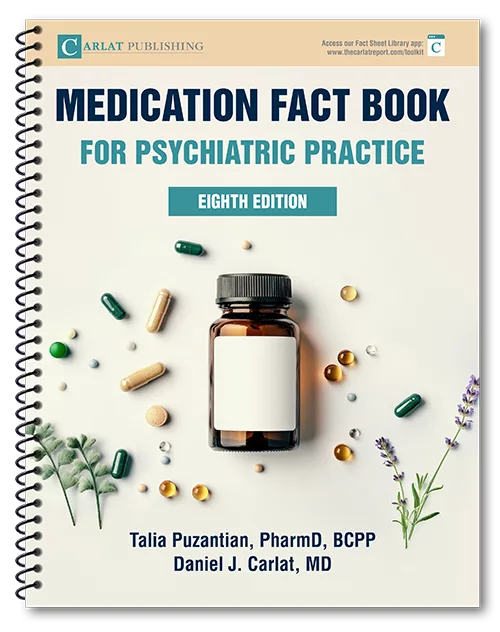Home » Mental Illness and Flourishing
EXPERT Q&A
Mental Illness and Flourishing
March 4, 2022
From The Carlat Psychiatry Report
 Margaret Chisolm, MD
Vice Chair for Education in Psychiatry and Behavioral Sciences at Johns Hopkins University. Author of From Survive to Thrive: Living Your Best Life With Mental Illness (2021).
Dr. Chisolm has disclosed no relevant financial or other interests in any commercial companies pertaining to this educational activity.
Margaret Chisolm, MD
Vice Chair for Education in Psychiatry and Behavioral Sciences at Johns Hopkins University. Author of From Survive to Thrive: Living Your Best Life With Mental Illness (2021).
Dr. Chisolm has disclosed no relevant financial or other interests in any commercial companies pertaining to this educational activity.
Photo credit: Greg Dohler
TCPR: You and other psychiatrists at Johns Hopkins have a way of viewing mental illness that differs from the biopsychosocial model. Tell us about that.
Dr. Chisolm: We use a model called “perspectives of psychiatry” that was developed by Paul McHugh and Phillip Slavney in the 1970s. It’s really a framework that considers the origin of patients’ problems through four lenses:
TCPR: Are some conditions better suited to particular lenses?
Dr. Chisolm: It might seem natural to view traumatic brain injury through the disease perspective; addictions and eating disorders through the behavior lens; personality as a dimension; and adjustment disorder as part of the life story. But the idea is that we gain a broader understanding of the origins of a patient’s problems, and can see new solutions, when we consider the patient’s presentation from all four perspectives.
TCPR: Can you give an example of how we might examine a specific problem from multiple perspectives under this model?
Dr. Chisolm: If someone with bipolar disorder has depression, we’d understand that mood episode has its origins in a broken structure or function in the brain (disease), but the episode could also have been partially precipitated by the interaction between perhaps a neurotic temperament and a particularly stressful provocation (dimensional), and/or, say, the person’s problematic drinking (behavior), and/or the person’s demoralization from having received the diagnosis of bipolar disorder (life story). Usually, at least two, if not three, of these perspectives are relevant to explaining the origin of a patient’s problems, and sometimes all four are at play.
TCPR: Do you use all four perspectives with every patient?
Dr. Chisolm: Absolutely. Sometimes I engage the patient in the process. I say, “This is how I think about things. Is it something you have? Is it because of who you are? Is this because of something you’re doing? Is this because of something you’ve encountered? How do you explain what’s going on?” Often they’ll say, “It’s all of the above.” And then I share my perspective with them, which might include diagnosis of a disease, assessment of the role of affective temperaments, identification of maladaptive conditioned behaviors, and discussion of the role of certain events in their life story.
TCPR: What are some questions that help you assess the dimensional perspective?
Dr. Chisolm: That one is the most challenging. I use the five-factor or “big five” model of personality, but I don’t give the official test (it is available at www.personal.psu.edu/~j5j/IPIP) (Editor’s note: See the “Five-Factor Model of Personality” table above). Instead, I use questions. For neuroticism, which is about strongly felt emotions, I might ask, “Are you a sensitive person who feels things really strongly?” For introversion/extroversion, I might ask, “If you are at a party and say the wrong thing, is that something that you dwell on a lot, or is it like water off a duck’s back?”
TCPR: What about the three other dimensions?
Dr. Chisolm: The openness dimension is a little more challenging. People with high levels of openness might have interests in art or abstract activities; they may be cultural explorers or physical risk-takers. For agreeableness, I ask about flexibility, such as, “Do you have problems adjusting when somebody changes plans at the last minute?” For conscientiousness, I ask, “How do you feel when somebody breaks a promise?” or, for the opposite of this trait, “Is your partner always nagging at you to pick up your socks or be cleaner and more orderly?” It’s also useful to get this information from family members because if the patient is in a depressed state, their answers may not be able to tell you much about their real personality due to the cognitive distortions that sometimes come with depression.
TCPR: How do you ask about the life story perspective?
Dr. Chisolm: The life story perspective is all about the meaning people give to events. For example, if their infant died of SIDS, I may ask, “How are you dealing with the loss? How do you understand it? How do you explain it?” They may blame themselves, or they may have a religious understanding of it. Part of the work is helping them rescript their story collaboratively. I might say, “You know, maybe there are other ways of looking at this. Could this be a random act of tragedy? How are you going to make meaning of this in terms of why it happened?”
TCPR: Do you assign tasks to help a patient rescript their story?
Dr. Chisolm: Journaling might be helpful, but I don’t typically assign homework because a lot of the people I see simply don’t do it. We do a lot of the work in session. I offer up interpretations, but I try to be very tentative about that and remain neutral and collaborative. This is the patient’s story. We have a lot of power as psychotherapists/psychiatrists, and I really don’t like to impose a story on someone. Many patients will simply agree with a story you tell, and that usually isn’t very helpful.
TCPR: What questions help you get at the behavior perspective?
Dr. Chisolm: I divide behaviors into innate and acquired drives. Innate drives include things we all do, like sleep, sex, and eating, and I screen for problems in each of those areas. Acquired drives include self-harm, which often has a behavioral conditioning component; substance use disorders; and digital addictions. If they have problems with any of these behaviors, I get all the details. I ask, “When do you drink? What role does drinking play in your life?” Or I ask, “What do you fantasize about sexually? Do you use pornography?”
TCPR: It sounds like these perspectives might help patients see other solutions for their problems—such as behavioral treatments for insomnia instead of just using hypnotics.
Dr. Chisolm: Definitely. This work helps patients think about their problems more broadly. It also helps with stigma because it gives alternatives to the disease model, which many patients find stigmatizing. It’s often much more affirming to talk about personality from a dimensional perspective with strengths and weaknesses than to label it a personality disorder. So, for neuroticism I may say, “You have an extra dose of feeling compared to the average person, and that works great in some situations but not so well in others.”
TCPR: What are some strengths of neuroticism?
Dr. Chisolm: If they notice a bump on their skin, they’re likely to go straight to a doctor about it, so they may catch problems earlier than someone who doesn’t worry much.
TCPR: This model sounds like it’s a way of looking at problems. What about a model of health?
Dr. Chisolm: For that, I’m more influenced by Tyler VanderWeele’s model of flourishing. Well-being—or flourishing—is more than the absence of mental illness. In fact, people can flourish in the face of mental illness. Flourishing encompasses feelings of happiness and life satisfaction, physical health, meaning and purpose, character and virtue, and close social relationships. These domains of flourishing are pretty similar to what philosophers have talked about for millennia when considering the question of what it means to lead a good life. Dr. VanderWeele wanted to know how someone could achieve this state of flourishing. He wanted to understand the pathways to the good life (VanderWeele TJ, Proc Natl Acad Sci U S A 2017;114(31):8148–8156; VanderWeele TJ et al, JAMA 2019;321(17):1667–1668).
TCPR: What did he arrive at?
Dr. Chisolm: He used an empirical approach—drawing causal links from large epidemiologic data sets—and identified four pathways to flourishing: family, community, work, and education. For community, he focused on religious community because that is where we have a lot of epidemiologic data. So, helping people strengthen where they are on these four flourishing pathways will support them in their quest not only for mental health, but also for overall well-being. Everyone wants to lead a good life, and a mental illness shouldn’t be an obstacle to leading the best life possible.
TCPR: Is flourishing something you address after recovery?
Dr. Chisolm: Not necessarily. Some patients don’t reach full recovery despite our best efforts, but they can still flourish through supportive family, being part of the community, getting meaningful work, and pursuing education at the level they are capable of. In schizophrenia, people’s abilities are usually not what they were before their illness began. Maybe their cognition is impaired, but they can still form close relationships, take care of their physical health, and find some meaning and purpose in a job or other activities. I also think patients are more likely to adhere to their medications or stay sober if these pathways are in place—if they have a reason to live and someone who cares how they are doing.
TCPR: Thank you for your time, Dr. Chisolm.
General Psychiatry Expert Q&ADr. Chisolm: We use a model called “perspectives of psychiatry” that was developed by Paul McHugh and Phillip Slavney in the 1970s. It’s really a framework that considers the origin of patients’ problems through four lenses:
- Disease perspective: Clinical syndromes that emerge from a “broken brain” (structure or function that has gone awry), like schizophrenia or bipolar disorder.
- Dimensional perspective: Personality, temperamental, or cognitive traits that are universal, graded, and measurable, like neuroticism or intellectual disability.
- Behavior perspective: Behaviors that are reinforced by conditioned learning that increases drive and narrows choice, like anorexia nervosa or addiction.
- Life story perspective: How people construct meaning or deal with recent or past events, like the loss of a loved one or sexual trauma.
| Neuroticism | Sensitive, nervous, and emotionally reactive vs resilient and confident |
| Extroversion | Outgoing and energetic vs solitary and reserved |
| Agreeableness | Friendly, flexible, and compassionate vs critical and rational |
| Openness to experience | Inventive, creative, and curious vs consistent and cautious |
| Conscientiousness | Efficient and organized vs extravagant and careless |
TCPR: Are some conditions better suited to particular lenses?
Dr. Chisolm: It might seem natural to view traumatic brain injury through the disease perspective; addictions and eating disorders through the behavior lens; personality as a dimension; and adjustment disorder as part of the life story. But the idea is that we gain a broader understanding of the origins of a patient’s problems, and can see new solutions, when we consider the patient’s presentation from all four perspectives.
TCPR: Can you give an example of how we might examine a specific problem from multiple perspectives under this model?
Dr. Chisolm: If someone with bipolar disorder has depression, we’d understand that mood episode has its origins in a broken structure or function in the brain (disease), but the episode could also have been partially precipitated by the interaction between perhaps a neurotic temperament and a particularly stressful provocation (dimensional), and/or, say, the person’s problematic drinking (behavior), and/or the person’s demoralization from having received the diagnosis of bipolar disorder (life story). Usually, at least two, if not three, of these perspectives are relevant to explaining the origin of a patient’s problems, and sometimes all four are at play.
TCPR: Do you use all four perspectives with every patient?
Dr. Chisolm: Absolutely. Sometimes I engage the patient in the process. I say, “This is how I think about things. Is it something you have? Is it because of who you are? Is this because of something you’re doing? Is this because of something you’ve encountered? How do you explain what’s going on?” Often they’ll say, “It’s all of the above.” And then I share my perspective with them, which might include diagnosis of a disease, assessment of the role of affective temperaments, identification of maladaptive conditioned behaviors, and discussion of the role of certain events in their life story.
TCPR: What are some questions that help you assess the dimensional perspective?
Dr. Chisolm: That one is the most challenging. I use the five-factor or “big five” model of personality, but I don’t give the official test (it is available at www.personal.psu.edu/~j5j/IPIP) (Editor’s note: See the “Five-Factor Model of Personality” table above). Instead, I use questions. For neuroticism, which is about strongly felt emotions, I might ask, “Are you a sensitive person who feels things really strongly?” For introversion/extroversion, I might ask, “If you are at a party and say the wrong thing, is that something that you dwell on a lot, or is it like water off a duck’s back?”
TCPR: What about the three other dimensions?
Dr. Chisolm: The openness dimension is a little more challenging. People with high levels of openness might have interests in art or abstract activities; they may be cultural explorers or physical risk-takers. For agreeableness, I ask about flexibility, such as, “Do you have problems adjusting when somebody changes plans at the last minute?” For conscientiousness, I ask, “How do you feel when somebody breaks a promise?” or, for the opposite of this trait, “Is your partner always nagging at you to pick up your socks or be cleaner and more orderly?” It’s also useful to get this information from family members because if the patient is in a depressed state, their answers may not be able to tell you much about their real personality due to the cognitive distortions that sometimes come with depression.
TCPR: How do you ask about the life story perspective?
Dr. Chisolm: The life story perspective is all about the meaning people give to events. For example, if their infant died of SIDS, I may ask, “How are you dealing with the loss? How do you understand it? How do you explain it?” They may blame themselves, or they may have a religious understanding of it. Part of the work is helping them rescript their story collaboratively. I might say, “You know, maybe there are other ways of looking at this. Could this be a random act of tragedy? How are you going to make meaning of this in terms of why it happened?”
TCPR: Do you assign tasks to help a patient rescript their story?
Dr. Chisolm: Journaling might be helpful, but I don’t typically assign homework because a lot of the people I see simply don’t do it. We do a lot of the work in session. I offer up interpretations, but I try to be very tentative about that and remain neutral and collaborative. This is the patient’s story. We have a lot of power as psychotherapists/psychiatrists, and I really don’t like to impose a story on someone. Many patients will simply agree with a story you tell, and that usually isn’t very helpful.
TCPR: What questions help you get at the behavior perspective?
Dr. Chisolm: I divide behaviors into innate and acquired drives. Innate drives include things we all do, like sleep, sex, and eating, and I screen for problems in each of those areas. Acquired drives include self-harm, which often has a behavioral conditioning component; substance use disorders; and digital addictions. If they have problems with any of these behaviors, I get all the details. I ask, “When do you drink? What role does drinking play in your life?” Or I ask, “What do you fantasize about sexually? Do you use pornography?”
TCPR: It sounds like these perspectives might help patients see other solutions for their problems—such as behavioral treatments for insomnia instead of just using hypnotics.
Dr. Chisolm: Definitely. This work helps patients think about their problems more broadly. It also helps with stigma because it gives alternatives to the disease model, which many patients find stigmatizing. It’s often much more affirming to talk about personality from a dimensional perspective with strengths and weaknesses than to label it a personality disorder. So, for neuroticism I may say, “You have an extra dose of feeling compared to the average person, and that works great in some situations but not so well in others.”
TCPR: What are some strengths of neuroticism?
Dr. Chisolm: If they notice a bump on their skin, they’re likely to go straight to a doctor about it, so they may catch problems earlier than someone who doesn’t worry much.
TCPR: This model sounds like it’s a way of looking at problems. What about a model of health?
Dr. Chisolm: For that, I’m more influenced by Tyler VanderWeele’s model of flourishing. Well-being—or flourishing—is more than the absence of mental illness. In fact, people can flourish in the face of mental illness. Flourishing encompasses feelings of happiness and life satisfaction, physical health, meaning and purpose, character and virtue, and close social relationships. These domains of flourishing are pretty similar to what philosophers have talked about for millennia when considering the question of what it means to lead a good life. Dr. VanderWeele wanted to know how someone could achieve this state of flourishing. He wanted to understand the pathways to the good life (VanderWeele TJ, Proc Natl Acad Sci U S A 2017;114(31):8148–8156; VanderWeele TJ et al, JAMA 2019;321(17):1667–1668).
TCPR: What did he arrive at?
Dr. Chisolm: He used an empirical approach—drawing causal links from large epidemiologic data sets—and identified four pathways to flourishing: family, community, work, and education. For community, he focused on religious community because that is where we have a lot of epidemiologic data. So, helping people strengthen where they are on these four flourishing pathways will support them in their quest not only for mental health, but also for overall well-being. Everyone wants to lead a good life, and a mental illness shouldn’t be an obstacle to leading the best life possible.
TCPR: Is flourishing something you address after recovery?
Dr. Chisolm: Not necessarily. Some patients don’t reach full recovery despite our best efforts, but they can still flourish through supportive family, being part of the community, getting meaningful work, and pursuing education at the level they are capable of. In schizophrenia, people’s abilities are usually not what they were before their illness began. Maybe their cognition is impaired, but they can still form close relationships, take care of their physical health, and find some meaning and purpose in a job or other activities. I also think patients are more likely to adhere to their medications or stay sober if these pathways are in place—if they have a reason to live and someone who cares how they are doing.
TCPR: Thank you for your time, Dr. Chisolm.
Issue Date: March 4, 2022
Table Of Contents
Recommended
Newsletters
Please see our Terms and Conditions, Privacy Policy, Subscription Agreement, Use of Cookies, and Hardware/Software Requirements to view our website.
© 2025 Carlat Publishing, LLC and Affiliates, All Rights Reserved.


_-The-Breakthrough-Antipsychotic-That-Could-Change-Everything.webp?t=1729528747)



